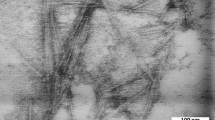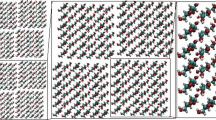Abstract
We have conducted a study of electric and spectral properties of the water–nanocellulose and water–nanocellulose–NaCl systems with different content of nanocellulose using dielectric and optical spectroscopy methods. We have demonstrated that the systems in which the content of nanocellulose was 0.08, 0.15, 0.3 and 0.6% undergo dielectric relaxation in the temperature range from –100 to 0 °C, whose nature is different from that of the pure water and explained by the dipole thermal polarization. The relaxation processes in both the water–nanocellulose and water–nanocellulose–NaCl systems were found to be due to the interaction between the surface layers of the cellulose nanocrystals and a hydration shell. The ions of Na+ and Cl− were found to distribute along the nanocellulose–ice interface and to partially block the formation of the hydrations shell around the nanocrystals of nanocellulose. Consequently, these ions were found to reduce the intensity of the dielectric relaxation process in the surface shells of the nanocellulose surrounded by a hydration shell.
Access this chapter
Tax calculation will be finalised at checkout
Purchases are for personal use only
Similar content being viewed by others
References
Thostenson ET, Li C, Chou TW (2005) Nanocomposites in context. Compos Sci Technol 65(3–4):491
Hsissou R, Seghiri R, Benzekri Z, Hilali M, Rafik M, Elharfi A (2021) Polymer composite materials: a comprehensive review. Compos Struct 262:113640
Demchenko V, Shtompel V, Riabov S, Lysenkov E (2015) Constant electric and magnetic fields effect on the structuring and thermomechanical and thermophysical properties of nanocomposites formed from pectin–Cu2+–polyethyleneimine interpolyelectrolyte–metal complexes. Nanoscale Res Lett 10(1):1
Lysenkov EA, Klepko VV, Yakovlev YV (2016) Specifics of percolation behavior in the polyether–carbon nanotube systems doped with LiClO4. Surf Eng Appl Electrochem 52(2):186
Fialko N, Dinzhos R, Sherenkovskii J, Meranova N, Navrodska R, Koseva N, Korzhyk V, Izvorska D, Lazarenko M (2021) Establishing patterns in the effect of temperature regime when manufacturing nanocomposites on their heat-conducting properties. EEJET 4(5):112
Kim JH, Shim BS, Kim HS, Lee YJ, Min SK, Jang D, Abas Z, Kim J (2015) Review of nanocellulose for sustainable future materials. IJPEM—GT 2(2):197
Saurabh CK, Adnan AS, Fazita MN, Syakir MI, Davoudpour Y, Rafatullah M, Abdullah CK, Haafiz MKM, Dungani R (2016) A review on chitosan-cellulose blends and nanocellulose reinforced chitosan biocomposites: properties and their applications. Carbohydr Polym 150:216
Rebouillat S, Pla F (2013) State of the art manufacturing and engineering of nanocellulose: a review of available data and industrial applications. JBNB 4(02):165
Marinho NP, de Cademartori PHG, Nisgoski S, de Andrade Tanobe VO, Klock U, de Muñiz GIB (2020) Feasibility of ramie fibers as raw material for the isolation of nanofibrillated cellulose. Carbohydr Polym 230:115579
Moon RJ, Martini A, Nairn J, Simonsen J, Youngblood J (2011) Cellulose nanomaterials review: structure, properties and nanocomposites. Chem Soc Rev 40:3941
Kargarzadeh H, Mariano M, Huang J, Lin N, Ahmad I, Dufresne A, Thomas S (2017) Recent developments on nanocellulose reinforced polymer nanocomposites: a review. Polymer 132:368
Li F, Mascheroni E, Piergiovanni L (2015) The potential of nanocellulose in the packaging field: a review. Packag Technol Sci 28(6):475
Zinge C, Kandasubramanian B (2020) Nanocellulose based biodegradable polymers. Eur Polym J 133:109758
Zabashta U, Lazarenko M, Alekseev A, Tkachev S, Vasylyuk S, Kovalchuk V, Bulavin L (2021) Mechanism of disorder genesis in cellulose microfibrils. Cellul Chem Technol 55(3–4):223–230
Voisin H, Bergström L, Liu P, Mathew AP (2017) Nanocellulose-based materials for water purification. Nanomaterials 7(3):57
Tao J, Jiao L, Deng Y (2021) Cellulose-and nanocellulose-based dielectric materials. In: nanocellulose based composites for electronics, Elsevier, pp 73–100
Nizam PA, Gopakumar DA, Pottathara YB, Pasquini D, Nzihou A, Thomas S (2021) Nanocellulose-based composites: fundamentals and applications in electronics. Elsevier, In nanocellulose based composites for electronics, pp 15–29
Wadher KJ, Bajaj GS, Trivedi RV, Trivedi SS (2021) Investigation of the influence of cellulose polymer on solid phase transformation of carbamazepine. J Cryst Growth 575:126358
Plackett D, Letchford K, Jackson J, Burt H (2014) A review of nanocellulose as a novel vehicle for drug delivery. Nord Pulp Paper Res J 29(1):105
Negi H, Sharma S, Singh RK (2021) Assessment of cellulose substituted with varying short/long, linear/branched alkyl groups for inhibition of wax crystals growth in crude oil. J Ind Eng Chem 104:458
Serpa A, Velásquez-Cock J, Gañán P, Castro C, Vélez L, Zuluaga R (2016) Vegetable nanocellulose in food science: a review. Food Hydrocoll 57:178
Gorade VG, Chaudhary BU, Kale RD (2021) Moisture management of polypropylene non-woven fabric using microcrystalline cellulose through surface modification. Appl Surf Sci Adv 6:100151
Hoeng F, Denneulin A, Bras J (2016) Use of nanocellulose in printed electronics: a review. Nanoscale 8(27):13131
Du X, Zhang Z, Liu W, Deng Y (2017) Nanocellulose-based conductive materials and their emerging applications in energy devices-a review. Nano Energy 35:299
Chornii V, Nedilko SG, Alekseev A, Terebilenko K, Boyko V, Lazarenko M, Revo S, Scherbatskyi V, Teselko P (2020) Properties of the micro/nanocrystalline cellulose filled with ZrO2: Eu, F particles. In: 2020 IEEE 40th international conference on electronics and nanotechnology ELNANO 2020. Proceedings, pp 297–301
Zhao H, Chen Z, Du X, Chen L (2019) Contribution of different state of adsorbed water to the sub-Tg dynamics of cellulose. Carbohydr polym 210:322
Due France KJ, Hoare T Cranston ED (2017) Review of hydrogels and aerogels containing nanocellulose. Chem Mater 29(11):4609
Alekseev O, Zabashta Y, Kovalchuk V, Lazarenko M, Bulavin L (2019) The structure of polymer clusters in aqueous solutions of hydroxypropyl cellulose. Ukr J Phys 64(3):238
Alekseev OM, Zabashta YF, Kovalchuk VI, Lazarenko MM, Rudnikov EG, Bulavin LA (2020) Structural transition in dilute solutions of rod-like macromolecules. Ukr J Phys 65(1):50
Kedzior SA, Gabriel VA, Dubé MA, Cranston ED (2020) Nanocellulose in emulsions and heterogeneous water-based polymer systems: a review. Adv Mater 33(28):2002404
Lazarenko MM, Nedilko SG, Alekseev SA, Tkachov SY, Shevtsov DO, Scherbatskyi VP, Barbash VA, Yablochkova KS, Ushcats MV, Kovalchuk VI, Andrusenko DA, Izvorska D, Dinzhos RV, Alekseev OM (2021) Electric and spectral properties of solid water-nanocellulose systems in a wide range of temperatures. International conference on nanotechnology and nanomaterials. Springer, Cham, pp 51–73
, Khouaja A, Koubaa A (2021) Daly HB Dielectric properties and thermal stability of cellulose high-density polyethylene bio-based composites. Ind Crops Prod 171:113928
Le Bras D, Strømme M, Mihranyan A (2015) Characterization of dielectric properties of nanocellulose from wood and algae for electrical insulator applications. J Phys Chem B 119(18):5911
Zhou Y, Huang X, Huang J, Zhang L, Zhou Z (2018) Predicting the dielectric properties of nanocellulose-modified presspaper based on the multivariate analysis method. Molecules 23(7):1507
Jose J, Thomas V, John J, Mathew RM, Salam JA, Jose G, Abraham R (2021) Effect of temperature and frequency on the dielectric properties of cellulose nanofibers from cotton. J Mater Sci Mater Electron 32(16):21213
Kovalov KM, Alekseev OM, Lazarenko MM, Zabashta YF, Grabovskii YE, Tkachov SY (2017) Influence of water on the structure and dielectric properties of the microcrystalline and nano-cellulose. Nanoscale Res Lett 12(1):468
Alekseev OM, Kovalov KM, Lazarenko MM, Lazarenko MV, Grabovskii YE, Tkachov SY (2019) Cell Chem Technol 53(1–2):15
Lazarenko M, Alekseev A, Zabashta Y, Tkachev S, Kovalchuk V, Andrusenko D,.Grabovsky Y, Bulavin L (2020) Estimation of water content in cellulose materials Cell Chem Technol 54(3−4):199
Marchessault RH, Morehead FF, Walter NM (1959) Liquid crystal systems from fibrillar polysaccharides. Nature 184:632
Mihranyan A, Llagostera AP, Karmhag R, Strømme M, Ek R (2004) Moisture sorption by cellulose powders of varying crystallinity. Int J Pharm 269(2):433
Kocherbitov V, Ulvenlund S, Kober M, Jarring K, Arnebrant T (2008) Hydration of microcrystalline cellulose and milled cellulose studied by sorption calorimetry. J Phys Chem B 112(12):3728
Barbash VA, Yaschenko OV, Shniruk OM (2017) Preparation and properties of nanocellulose from organosolv straw pulp. Nanoscale Res Lett 12(1):241
Barbash V, Yashchenko O, Kedrovska A (2017) Preparation and properties of nanocellulose from peracetic flax pulp. J Sci Res Rep 16(1):1
Barbash VA, Yashchenko OV, Opolsky VO (2018) Effect of hydrolysis conditions of organosolv pulp from kenaf fibers on the physicochemical properties of the obtained nanocellulose. Theor Exp Chem 54(3):193
Alekseev AN, Lazarenko MM, Lazarenko MV, Kovalev KN, Tkachev SY (2017) Characterization of dielectric properties in liquid–solid phase transition. Inorg Mater 53(15):1473
Lazarenko MM, Hnatiuk KI, Alekseev SA, Yablochkova KS, Dinzhos RV, Ublekov F, Lazarenko MV, Andrusenko DA, Alekseev AN (2020) Low-temperature dielectric relaxation in the system silica gel–undecylenic acid. In: 2020 IEEE 10th international conference nanomaterials: applications and properties, IEEE, 01NIC02–1
Hölzl C, Forbert H, Marx D (2021) Dielectric relaxation of water: assessing the impact of localized modes, translational diffusion, and collective dynamics. Phys Chem Chem Phys 23(37):20875
Zarzycki P, Gilbert B (2020) Temperature-dependence of the dielectric relaxation of water using non-polarizable water models. Phys Chem Chem Phys 22(3):1011
Popov I, Ishai PB, Khamzin A, Feldman Y (2016) The mechanism of the dielectric relaxation in water. Phys Chem Chem Phys 18(20):13941
Nandi N, Bagchi B (1997) Dielectric relaxation of biological water. J Phys Chem B 101(50):10954
Yang W, Jiao L, Liu W, Dai H (2019) Manufacture of highly transparent and hazy cellulose nanofibril films via coating TEMPO-oxidized wood fibers. Nanomaterials 9(1):107
Nogi M, Iwamoto S, Nakagaito AN, Yano H (2009) Optically transparent nanofiber paper. Adv Mater 21(16):1595
Simão CD, Reparaz JS, Wagner MR, Graczykowski B, Kreuzer M, Ruiz-Blanco YB, García Y, Malho JM, Goñi AR, Ahopeltoc J, Sotomayor Torre CM (2015) Optical and mechanical properties of nanofibrillated cellulose: towards a robust platform for nextgeneration green technologies. Carbohydr Polym 126:40
Pikulev V, Loginova S, Gurtov V (2012) Luminescence properties of silicon-cellulose nanocomposites. Nanoscale Res Lett 7:426
Nedielko M, Hamamda S, Alekseev O, Chornii V, Dashevskii M, Lazarenko M, Scherbatskyi V (2017) Mechanical, dielectric, and spectroscopic characteristics of “micro/nanocellulose+ oxide” composites. Nanoscale Res Lett 12(1):98
Grönroos P, Bessonoff M, Salminen K, Paltakari J, Kulmala S (2018) Phosphorescence and fluorescence of fibrillar cellulose films. Nord Pulp Paper Res J 33:246
Ding Q, Zhang P (2021) Revealing the autofluorescence properties of nanocellulose isolated from different raw materials by different methods. In IOP Conf Ser: Earth Environ Sci 639(1):012037
Adachi C, Tsutsui T (2006) Fundamentals of luminescence: luminescence of organic compounds. Applied Chemistry. CRC Press, pp 51–59
Lazarenko MM, Alekseev AN, Alekseev SA, Yablochkova KS, Bokhvan SI, Demidiuk OF, Lazarenko MV (2020) Topological solitons in aliphatic systems with a restricted translational mobility. Chem Phys 539:110959
Lazarenko MM, Alekseev AN, Alekseev SA, Hnatiuk KI, Demidiuk OF, Yablochkova KS, Atamas NO, Lazarenko MV (2020) Topological solitons in chain molecular crystals with stoichiometric obstacles and hydrogen bonds. J Phys Chem Solids 144:109514
Tkachev SY, Alekseev OM, Lazarenko MM, Lazarenko MV, Kovalov KM, Bokhvan SI, Grabovskii YE, Hoshylyk NV (2018) Topological solitons in branched aliphatic molecules. Mol Cryst Liq Cryst 665(1):166
Hoffman JD, Williams G, Passaglia E (1966) Analysis of the α, β, and γ relaxations in polychlorotrifluoroethylene and polyethylene: Dielectric and mechanical properties. J Polym Sci C (14)1:173
Fröhlich H (1958) Theory of dielectrics: dielectric constant and dielectric loss. Clarendon Press, pp 192
Author information
Authors and Affiliations
Corresponding author
Editor information
Editors and Affiliations
Rights and permissions
Copyright information
© 2023 The Author(s), under exclusive license to Springer Nature Switzerland AG
About this paper
Cite this paper
Lazarenko, M.M. et al. (2023). Dielectric and Photoluminescent Properties of the Water–Cellulose–NaCl Systems in a Wide Range of Temperatures: What is the Role of Ions?. In: Fesenko, O., Yatsenko, L. (eds) Nanooptics and Photonics, Nanochemistry and Nanobiotechnology, and Their Applications . Springer Proceedings in Physics, vol 280. Springer, Cham. https://doi.org/10.1007/978-3-031-18104-7_29
Download citation
DOI: https://doi.org/10.1007/978-3-031-18104-7_29
Published:
Publisher Name: Springer, Cham
Print ISBN: 978-3-031-18103-0
Online ISBN: 978-3-031-18104-7
eBook Packages: Physics and AstronomyPhysics and Astronomy (R0)




